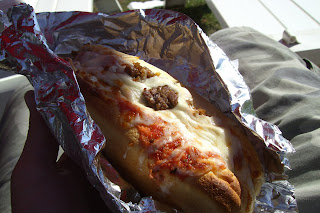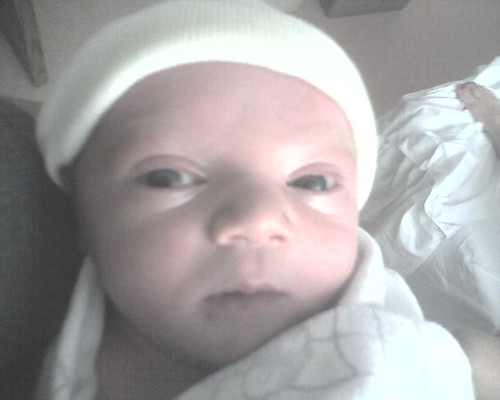Friday, August 31, 2007
State Fair Update
I found a new player for next year. This guy is sweet. His shirt unironically features a Trans Am logo.
Posted by Chris at 9:22 PM 0 comments
State Fair Update
I found a new player for next year. This guy is sweet. His shirt unironically features a Trans Am logo.
Posted by Chris at 9:20 PM 0 comments
Minnesota State Fair Food

Posted by Chris at 9:15 PM 0 comments
Thursday, August 30, 2007
Wednesday, August 29, 2007
brownies with chipotle-cherry whipped cream

Bon Appétit | March 2007 A dollop of chipotle-cherry whipped cream adds a sweet and spicy note to purchased brownies.
Makes 6 servings.
ingredients
1 cup chilled heavy whipping cream
1/4 cup chopped cherry preserves
1/4 teaspoon canned chipotle adobo sauce
1/4 teaspoon vanilla extract
1/8 teaspoon almond extract
Purchased brownies
preparation
In a large bowl, whisk heavy whipping cream with chopped cherry preserves, chipotle adobo sauce, vanilla extract, and almond extract until peaks form. Serve with brownies.
Epicurious.com © CondéNet, Inc. All rights reserved.
Posted by Chris at 1:39 PM 0 comments
Monday, August 27, 2007
2007 Punchy Awards
 The long awaited 2007 Punchy Awards will be held Friday September 28 at the beautiful downtown Buca di Beppo. Come join the glamerous mens and ladies of Minneapolis Co-Ed D-League softball at this gala event.
The long awaited 2007 Punchy Awards will be held Friday September 28 at the beautiful downtown Buca di Beppo. Come join the glamerous mens and ladies of Minneapolis Co-Ed D-League softball at this gala event.
View the eVite
We'll have awards for MVP, Sexiest Man, and some other olde standbyes. We are looking for some new award ideas too so suggest something.
Past Punchy Award Winners
Posted by Chris at 11:11 AM 0 comments
Sunday, August 26, 2007
New Bulldog
Posted by Chris at 12:00 PM 1 comments
Elvis Lives
The Punchies will be held on a Friday in late September. A formal announcement will follow later this week. Have any ideas for new award categories? Submit your ideas by clicking on add a comment.
Posted by Chris at 12:00 PM 0 comments
Friday, August 10, 2007
Marlboro Chew
Team, you need to be aware of these new performance enhancing products for next season. Don't be afraid to overindulge. It worked for Barry and also for this guy.
 | ||
| Camel Snus and Philip Morris' Taboka are two types of smokeless, spitless tobacco products. | ||
If he were conceived today, there might not be just a cigarette dangling from his mouth. He might also have, tucked into his pocket, a cellphone-size container holding a dozen pouches of snus.
Snus?
It rhymes with "goose," (cynics might say "noose"), and is a Swedish type of smokeless tobacco that's not your grandfather's dip or chew. Snus comes in teabag-like pouches that a user sticks between the upper lip and gum, leaves there for up to 30 minutes and discards without spitting.
As no-smoking laws sweep the nation and cigarette sales continue to fall, Big Tobacco is alarming the public health community by devising other ways to try to make tobacco appealing. With smokeless products representing the only booming part of the U.S. tobacco market, snus is an effort to boost sales with a product that — unlike most smokeless ones — doesn't require users to spit out the residue.
Snus also represents something more: an attempt to move smokeless tobacco beyond stereotypical users such as baseball players and rodeo cowboys, and into offices or restaurants where people want a nicotine fix but can't light up.

"This is a growth strategy for us," says Bill Phelps, spokesman for Philip Morris USA, the nation's biggest tobacco company and maker of Marlboro, the top-selling cigarette. In Dallas this month, Philip Morris is launching its first smokeless product with a cigarette brand name: Marlboro Snus.
R.J. Reynolds, second in U.S. tobacco sales, is expanding tests of its Camel Snus from two cities to eight, which will include Dallas this month. Its ads have a "pleasure for wherever" tagline and a playful tone. Its "abridged guide to snusing" says, "Picture yourself stuck in the center seat 44B of an airplane: You can mope, or you can Snus."
Public health advocates aren't smiling.
Although some say smokeless tobacco poses fewer health risks than cigarettes, they note that it has been linked to various types of cancer and warn against using any tobacco product.
"What on the surface looks promising could turn out to be a public health disaster," says Gregory Connolly, director of tobacco control research at Harvard School of Public Health.
He says the products are still addictive, and unless the Food and Drug Administration can regulate tobacco, consumers won't know what's truly in snus. A bill that would give the FDA such authority passed a U.S. Senate panel Wednesday and is gaining co-sponsors in the U.S. House.
Under laws in every state, snus and other tobacco products may not be sold to anyone younger than 18. But many health advocates see the new smokeless alternatives as an attempt to create a new generation of tobacco users.
Snus will "increase the number of people who use tobacco," says Matthew Myers, president of the Campaign for Tobacco-Free Kids. "It's market protection. This way, the big companies win no matter what tobacco products people use."
'It's the smoke, stupid'
Cigarette sales in the USA have fallen steadily for two decades as tobacco taxes have risen, studies have warned of health risks and laws have expanded smoke-free zones from indoor spaces to outdoor areas such as parks.
Government figures indicate 44.5 million Americans smoke, down from a peak of 53.5 million in 1983.
The only part of the tobacco market in which sales are soaring is "moist snuff" such as Skoal and Copenhagen, which are placed between the lower lip and gum but not chewed. Other types of smokeless tobacco, including chewing tobacco and "dry snuff," have fallen in popularity. Snus is most akin to moist snuff.
Sales of moist snuff in the USA more than doubled in volume from 1986 to 2005, according to a report this year by the Federal Trade Commission. Tobacco companies' spending on promoting such products rose more than five-fold.
Nik Modi, a tobacco industry analyst at UBS, a financial services firm, projects that the sales volume of moist snuff will rise 6% to 8% a year through 2010.
"It's becoming more socially acceptable," says Dan Butler, president of the U.S. Smokeless Tobacco, the nation's biggest seller of smokeless products including Skoal and Copenhagen.
He says 6.1 million Americans used moist snuff in 2006, up from 4.7 million in 2001. He says most of the new users are smokers, some of whom still light up.
The new smokeless, spit-free products are "an effort to create a different tobacco category in the United States," says Tommy Payne, executive vice president for public affairs of Reynolds American, parent company of R.J. Reynolds.
He thinks snus will gain acceptance because it's convenient and discreet. Payne adds that scientific studies show that smokeless products pose fewer health risks than cigarettes, largely because the tobacco is not burned and inhaled into the lungs.
"It's the smoke, stupid," he says.
A debate over the risks
Even so, the major tobacco companies are careful not to make any advertising claims that their smokeless products have fewer health risks.
Snus containers carry one of three required warning labels that say the product is either "not a safe alternative to cigarettes," "may cause mouth cancer" or "may cause gum disease and tooth loss."
The American Cancer Society, in a study of 116,000 men published in February, says male smokers who gave up cigarettes for smokeless tobacco still had higher death rates from lung cancer, heart disease and strokes than men who quit all tobacco or never smoked.
 Several studies that compare smokeless tobacco to cigarettes, however, find smokeless less harmful. A study published in May in The Lancet, a British medical journal, tracked nearly 280,000 Swedish construction workers from 1978-1992 and found that smokers were at least 10 times more likely to get lung cancer than snus users.
Several studies that compare smokeless tobacco to cigarettes, however, find smokeless less harmful. A study published in May in The Lancet, a British medical journal, tracked nearly 280,000 Swedish construction workers from 1978-1992 and found that smokers were at least 10 times more likely to get lung cancer than snus users.
The study, done by an international team of public health researchers, and funded by the Swedish Cancer Society, said snus users were not at increased risk for oral cancer. It found that they were twice as likely to get pancreatic cancer as those who never used tobacco but their risks were lower than those for smokers.
Smokers should be encouraged to quit tobacco entirely, but they also should be told that smokeless products have fewer risks than cigarettes, says Jonathan Foulds, director of the tobacco dependence program at the University of Medicine and Dentistry of New Jersey.
Foulds says Swedes' widespread use of snus has helped lower the adult male smoking rate there to among the lowest in Europe. Snus, though legal in Sweden, has been banned in most of Europe as cancer-causing and a gateway to smoking for young people. Cigarettes, however, are legal.
Snus use alone did not cause Sweden's smoking rate to fall, says Harvard's Connolly. He says high cigarette prices along with bans on cigarette advertising and indoor smoking played a greater role.
"All forms of tobacco are bad," he says, adding that the new smokeless products won't help American smokers kick the habit. "It's like setting up a methadone program next to a drug house and keeping your fingers crossed and hoping it all works out."
Snus products have varying levels of nicotine. Connolly says Taboka, Philip Morris' first smokeless offering, actually creates a craving for a cigarette.
Foulds says Taboka delivers almost no nicotine. He likens it to Ford or GM building a car with four wheels but no gas. In Sweden, he says snus products have enough nicotine to help smokers get off cigarettes.
Philip Morris' Phelps says a pouch of Taboka contains slightly more nicotine than a pouch of any of the four flavors of Marlboro Snus. He says he cannot compare the nicotine of a snus packet to that of a cigarette because nicotine is measured differently in the products.
Bonnie Herzog, a tobacco industry analyst at Citigroup, says in a July survey of tobacco wholesalers and retailers that most respondents do not believe snus will prompt smokers to quit. Instead, they say smokers will use snus in addition to cigarettes.
A marketing challenge
Health concerns aside, such products could be a tough sell for tobacco companies.
"There's such a stigma attached to smokeless products," says Kylie Meiner, tobacco prevention coordinator for the health department in Multnomah County, which includes Portland, Ore., a test market for Camel Snus. She says such products generally do not appeal to well-educated people.
The challenge is getting a smoker "to create a new behavior," says Butler of U.S. Smokeless Tobacco Co. He says its first spit-free product, Revel, was launched in two markets several years ago and "failed to achieve a breakthrough."
Other new smokeless products also have struggled or failed.
"It has been slow going," says Sara Troy Machir, a spokeswoman for Star Scientific, a small Virginia company that makes dissolvable tobacco lozenges known as Arriva and Stonewall. She says awareness of the products is increasing, however.
"It's going to take some time for these products to take off," says Modi, the tobacco industry analyst. For that to happen, he says, they have to work. In other words, they have to give people a nicotine buzz.
So far, Taboka hasn't been "lighting the world on fire, no pun intended," Modi says.
A USA TODAY visit to a dozen convenience, tobacco and Wal-Mart stores in Indianapolis found Taboka widely available, often in a dispensers displayed near Marlboro cigarettes and priced at $1.20 to $3.80 per pack. Retailers say consumers have shown little interest.
"I haven't sold any at all," says Pat Bowman at The Tobacco Shop. He says even people who had coupons for free samples didn't want Taboka once they knew what it was. "I couldn't give it away."
R.J. Reynolds' Payne says one pouch of Camel Snus offers about as much nicotine as a cigarette.
In Wake County, N.C., where Camel Snus was launched last month, several smokers gave it a thumbs-down, says Gibbie Harris, the county's health director. Ten smokers in her agency tried it. She says "the women didn't like it at all," partly because they found it wasn't entirely spit-free.
Payne says if used correctly — placed between the upper lip and gum, not the lower lip — snus should not require spitting, because there's less saliva in the upper lip.
The marketing savvy of big tobacco companies worries public-health advocates such as Harvard's Connolly. "If anyone can get the taste and nicotine right, it's Philip Morris," he says, noting the allure of the Marlboro brand name.
Connolly says the health community should play no part in helping the industry expand tobacco sales share by acknowledging snus as a safer product.
"We shouldn't be out there promoting harm," Connolly says, "even reduced harm."
| Find this article at: http://www.usatoday.com/news/nation/2007-08-06-snus_N.htm |
Posted by Chris at 12:32 PM 1 comments






